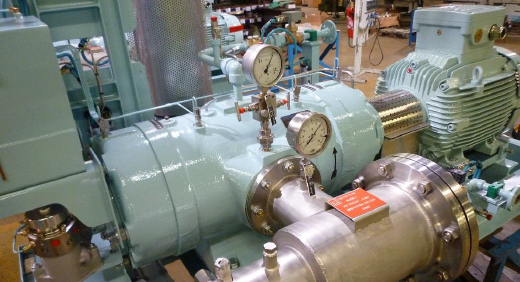This type of compressor is used for pumping out gases of vacuum systems, bulk cargo unloading and transshipment systems, in water treatment plants for water aeration and compressing noxious and corrosive gases. The liquid-ring compressor is simple in design and related to the positive displacement type of machine. Depending on the application, single-stage and two-stage configurations can be used.

The principle of operation of a liquid-ring compressor is as follows. The compressor’s shaft and blades rotate in the cylindrical casing without touching it. The shaft and casing are non-coaxial. The operating liquid is fed to the inside of the compressor. In most cases water is used as the operating liquid, but in certain cases oil, alkali or acid can be used as well. During the shaft rotation the liquid is thrown off to the wall of the compressor’s casing. At the top the internal surface of the liquid ring touches the compressor’s shaft, at the bottom a variable-volume space is formed between the shaft and the liquid ring. In the direction of rotation of the shaft gas initially finds its way to the suction port and then due to rotation of the shaft travels to the discharge port. The space between the shaft and the liquid ring is gradually decreased, as a result of which gas compression takes place.
The liquid-ring compressor is capable of running if pressure in suction piping is considerably lower than atmospheric pressure.
The liquid-ring compressor’s throughput can be controlled by a bypass line, changing the rotational speed of the compressor’s shaft and gas throttling at suction.
The drive unit of a liquid-ring compressor may be composed of an electric motor or gasoline, diesel or gas engine. In each particular case, the selection of the type of drive is based on the compressor’s power requirement and availability of fuel reserves or electricity necessary to ensure its operation.
The liquid-ring compressors are capable of flowing up to 10,000.00 actual cubic meters per hour of compressed gas (in terms of suction) at pressures of up to 1.4 MPa (abs.) at discharge.
